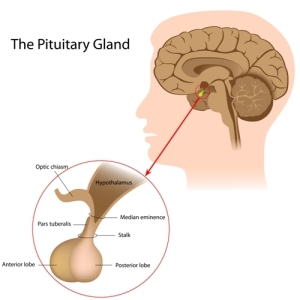Introduction
Here I am describing pituitary gland disorders. The pituitary gland is one of the central regulating hormone glands that responds to mostly stimulatory hormones from the hypothalamus gland. But it also responds to inhibitory stimuli from the hormone glands in the body.
I pointed out elsewhere how important feedback systems are to the regulation of hormone production. The pituitary gland is intimately related to adrenal gland function (via cortisol hormones), the function of the thyroid gland (via T3 and T4 hormones) and to the function of the male hormones and female hormones (testosterone and estrogen). The release of prolactin is inhibited by dopamine (from the hypothalamus). This hormone is only released in a lactating woman and is regulated through the dopamine flow from the hypothalamus. This is diminished after the delivery of a baby leading to release of prolactin from the pituitary gland and lactation of the breasts.
Unfortunately there are conditions like hypothalamus tumors (meningiomas, metastases of other cancers etc.) or severe head trauma, which can interrupt the flow of dopamine from the hypothalamus to the pituitary gland thus releasing prolactin and this can cause breast milk production in both males and females.
The pituitary gland has two separate compartments, the larger front part, called anterior lobe, and the smaller back part, called posterior lobe. Each of them produce a separate set of hormones as follows:
Pituitary Hormones and their effects on the body
| Anterior lobe hormones: | Target or actions of pituitary hormones: | End result of hormone action: |
| ACTH (adrenocorticotropic hormone) | cortisol release from adrenal glands | helps to adjust to stress |
| GH (growth hormone) | fat and liver cell metabolism stimulated | growth of muscles and skeleton |
| TSH (thyroid stimulating hormone) | production of T3 and T4 thyroid hormones | increase of protein production and oxygen consumption in all cells |
| LH (luteinizing hormone) | stimulates ovarian estrogen/progesterone and stimulates testosterone in testicles | helps with puberty; essential for ovulation; in the male stimulates testosterone production by the testicles |
| FSH (follicle stimulating hormone) | similar to LH, targets ovaries or testicles | both LH and FSH needed for normal function |
| Prolactin | milk ducts of breasts | milk production (lactation) |
| Posterior lobe hormones: | Target or actions of pituitary hormones: | End result of hormone action: |
| ADH (antidiuretic hormone) | kidney is prompted to reabsorb more water | water preservation in the body |
| Oxytocin | uterine muscle, brain relaxation | uterine contractions, “cuddling” hormone |
References:
1. B. Sears: “The age-free zone”. Regan Books, Harper Collins, 2000.
2. R.A. Vogel: Clin Cardiol 20(1997): 426-432.
3. The Merck Manual, 7th edition, by M. H. Beers et al., Whitehouse Station, N.J., 1999. Chapter 8: Thyroid disorders.
4. The Merck Manual, 7th edition, by M. H. Beers et al., Whitehouse Station, N.J., 1999. Chapter 7:Pituitary disorders.
5. J Levron et al.: Fertil Steril 2000 Nov;74(5):925-929.
6. AJ Patwardhan et. al.: Neurology 2000 Jun 27;54(12):2218-2223.
7. ME Flett et al.: Br J Surg 1999 Oct;86(10):1280-1283.
8. The Merck Manual, 7th edition, by M. H. Beers et al., Whitehouse Station, N.J., 1999. Chapter 261: Congenital anomalies.
9. AC Hackney : Curr Pharm Des 2001 Mar;7(4):261-273.
10. JA Tash et al. : Urology 2000 Oct 1;56(4):669.
11. D Prandstraller et al.: Pediatr Cardiol 1999 Mar-Apr;20(2):108-112.
12. B. Sears: “Zone perfect meals in minutes”. Regan Books, Harper Collins, 1997.
13. J Bain: Can Fam Physician 2001 Jan;47:91-97.
14. Ferri: Ferri’s Clinical Advisor: Instant Diagnosis and Treatment, 2004 ed., Copyright © 2004 Mosby, Inc.
15. Rakel: Conn’s Current Therapy 2004, 56th ed., Copyright © 2004 Elsevier







